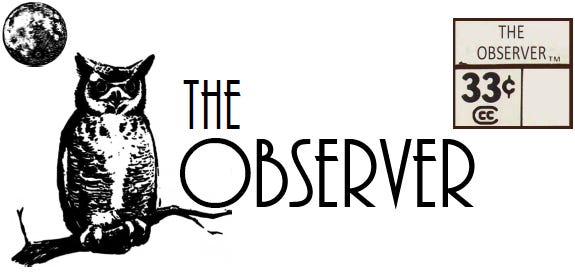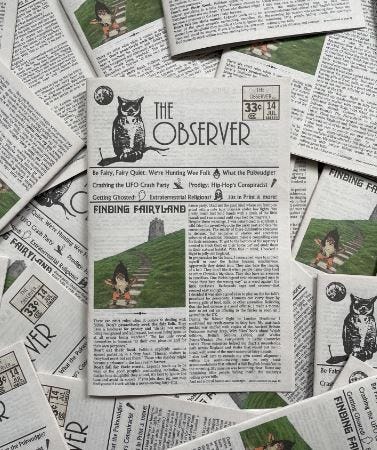“...‘once upon a time’ the world was less practical in it’s facts than now, less commonplace and humdrum, less subject to the inexorable laws of gravitation, optics and the like. What dramas it has yielded! What poems, what dreams, what delights!”
Wirt Sikes, 1880
I rarely talk about the time I woke up to a coven of black-caped, green-skinned, pointy-hat-wearing witches invading my house.
It happened on a summer day while I was coming out of a quick nap on the couch. As soon as I opened my eyes, I was overwhelmed by a distinct impression that something in the room wasn’t right. Things felt off … like that creepy feeling you got as a kid when you’d run up to some lady in the mall that you swore was your mom from the side, but then when she turned her head in response to you asking if you could stop at Wendy’s on the way home for a Jr. Bacon Cheeseburger you saw her face and OH MY GOD THAT’S NOT MY MOM!! IS THIS LADY A DECOY? IS THIS A TRAP?! WHERE’S KATHY??
That was the level of creepiness I felt as I lay paralyzed on my living room sofa. After attempting to sit up and finding myself unable to move a muscle, my initial impression of general uneasiness blossomed into full- fledged panic.
The feeling escalated when I spotted a large figure clad in a flowing black cloak rustling around in the front hallway. Nobody else was home that afternoon so the presence by the entryway felt intensely foreign and out-of-place. The shadowy entity was careful to remain outside my direct field of view, but I saw enough to know that it gave off a distinct ‘wicked-character-from- The-Wizard-of-Oz’ type vibe. Naturally I suspected a witch. A witch would explain my lack of mobility. Witches love to cast disabling spells.
While the shadow person at the front door busied itself with typical shadow-people shenanigans, I tried to break the curse by moving an arm or a leg—any appendage—without luck. During this brief and fruitless exercise, my witch infestation problem quickly compounded. An additional commotion was now coming from the opposite side of the house. Through a line of windows overlooking a wooded backyard, I could just make out a duo of dark silhouettes walking onto the porch. They scuttled back and forth between the windows and the sliding glass door, frantically searching for a way inside. Their movements expressed a desperate sense of urgency to reunite with the creature who had already made a foray into my foyer.
As the bizarre scene unfolded around my paralyzed form, I became convinced I wasn’t dreaming. The familiar layout of the living room was too visceral, and the awareness of my body too tangible, for the scene to be taking place solely in my head.
Almost a minute went by before I was able to channel my best imitation of a crippled Uma Thurman in Kill Bill—willing my unresponsive limbs to MOVE!—and regain my mobility.
I did so all at once, shooting up wildly while scanning the corners of the room for my daytime intruders. There were no signs of them. The witches who spent the last 60 seconds ransacking my home had vanished as quickly as they’d appeared.
I later learned about sleep paralysis and the hypnopompic hallucinations that manifest when someone’s mind wakes up before their body does. The witches I saw committing a B&E were really just dark smudges occupying the outskirts of my vision—mere mirages of the mind
Setting aside my run-in with the hags from Macbeth, I’ve never had a real brush with the paranormal. Supernatural entities avoid me like girls did in high school. Yet their reluctance to manifest hasn’t diminished my desire to believe that our world is haunted by all sorts of inexplicable phenomena.
What fuels this motivation in the face of limited evidence and a lack of firsthand experience?
In Why People Believe Weird Things (1997), everyone’s favorite skeptic
takes a stab at this question. He acknowledges that a predilection for high strangeness fulfills a longstanding human need: “There is a joy in exploring the world’s greatest mysteries, even when final answers are not forthcoming.” People seek novelty and the possibility of encounters with the unknown.Shermer cites Science as a major contributor to the persistence of paranormal belief today. He contends that we live in “an Age of Science” that dramatically influences what we think we know about our physical world. It also shapes our ideas about the things that exist in ‘the realm of the unknowable.’
This era of increased knowledge and advanced technology is more than a candle in the dark—it’s a spotlight in a broom closet. Blinding clarity is directed at every gloomy corner in hopes of eliminating the unknown. Humanity’s natural reaction to this manufactured shortfall is to vehemently search for outstanding vestiges of high strangeness—areas where logic doesn’t govern and question marks remain.
In other words, it’s not that people believe weird things in spite of scientific progress, but because of it.
Cultural historian Colin Dickey’s book The Unidentified (2020) picks up this thread, exploring why interest in fringe topics persists despite an uptick in scientific progress. He frames paranormal belief as “an attempt to find meaning in a world stripped of wonder.” In a demystified universe void of magic, where everything can be reduced to its atomic structure and cataloged accordingly, society yearns for “a world reenchanted.”
People long to explore hidden realities because they want to believe that there are still “things slightly beyond our understanding.” We hope for the existence of anomalous worlds where “basic facts are simply unknowable.”
Dickey points out that there are no more “empty spaces on the map.” Cultures grapple with this dearth of unexplored places by creating new ones in harder-to-reach locations: Atlanteans inside a hollow earth, aliens on the dark side of the moon, entities in an invisible spirit realm.
Author Mark Fitch reaches similar conclusions in Paranormal Nation: Why America Needs Ghosts, UFOs, and Bigfoot (2013). Sticking with the map analogy, Fitch laments the fact that our charts are no longer full of mythical creatures and half-drawn coastlines; faceless frontiers that were sources of motivation and enlightenment for ancient explorers. These days, maps aren’t “documents of the mysterious and unknown, but rather, the very details of the known world.”
Arcane and mystical experiences become difficult to locate when every hill and valley is surveyed and named. In response, we look to uncover regions that “do not comprise the rational and known world of maps.”
Humans have an innate drive to want to believe in the unbelievable. Fitch suggests that “the paranormal calls into question all that we believe we know about reality,” thus providing humanity with an essential mystery to ponder and latch onto. The supernatural world serves as a “totem” for the limits of consensus reality.
I tend to agree with the premise that the more well-trodden our planet becomes, the more our belief in the paranormal endures. Our culture suffers from a ‘deficit of the unfamiliar.’ The hinterlands are disappearing. As the “Age of Science” encroaches even further into the realm of high strangeness, the impulse to embrace a supernatural worldview can be seen as a timeless expression of our species’ inherent curiosity and a fundamental aspect of human nature.
Even though my own witchy encounter was a mundane misinterpretation, I don’t discount the possibility that others have mingled with members from a hidden reality. I still believe that people can have authentic interactions with inexplicable entities. Despite removing a layer of mystery, my curiosity remains intact. In a world where magic is mechanical and the supernatural is secular, paranormal beliefs offer a way to engage with a dwindling sense of mystery and wonder.
P.S. Issue #15 is on the way.
















I hope humanity never stops being curious or looking for the unknown. We'll lose something if we do.
Very interesting!